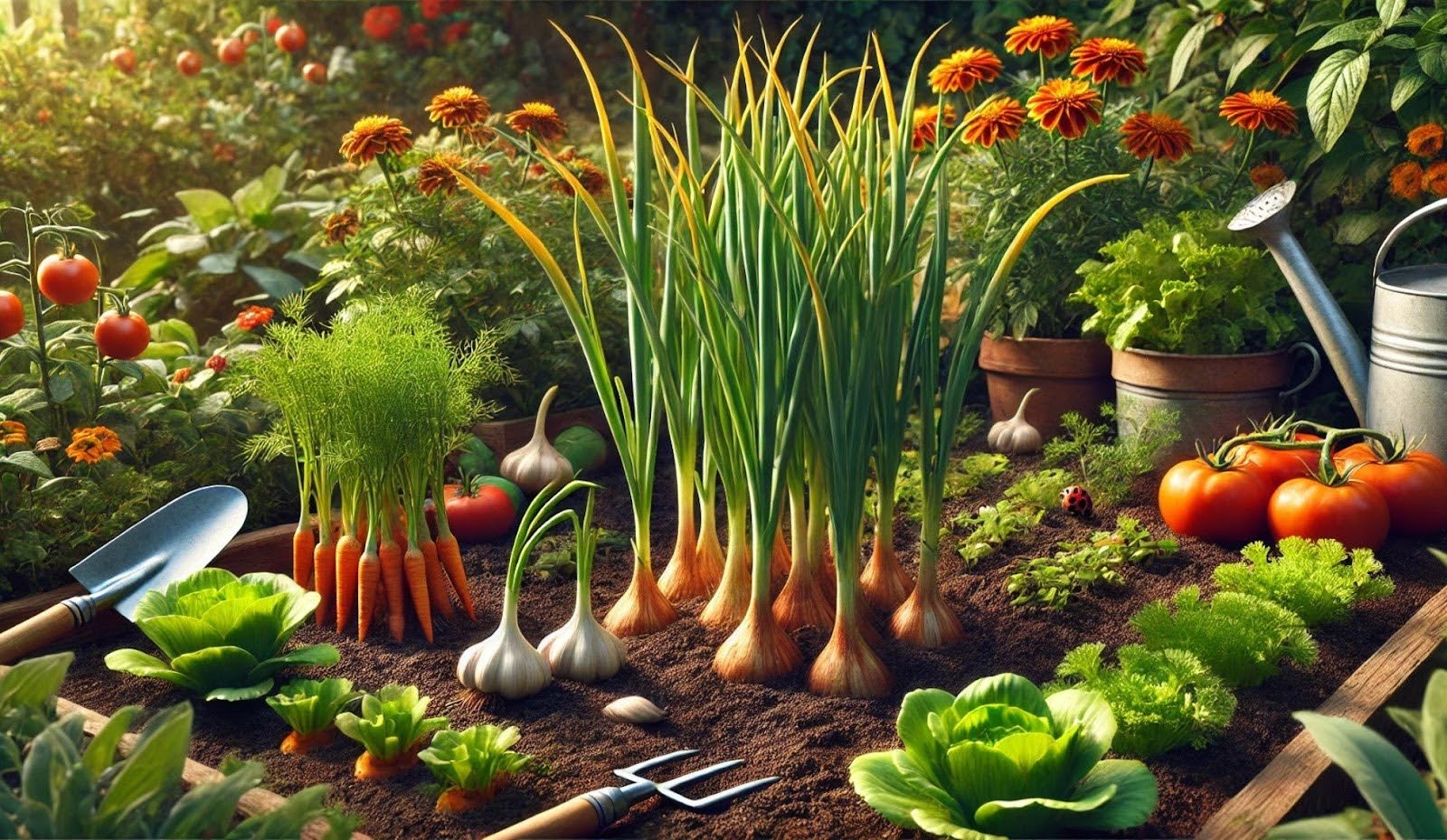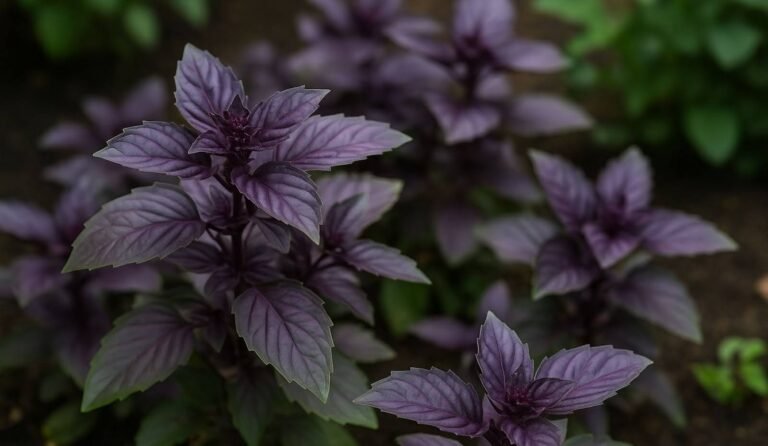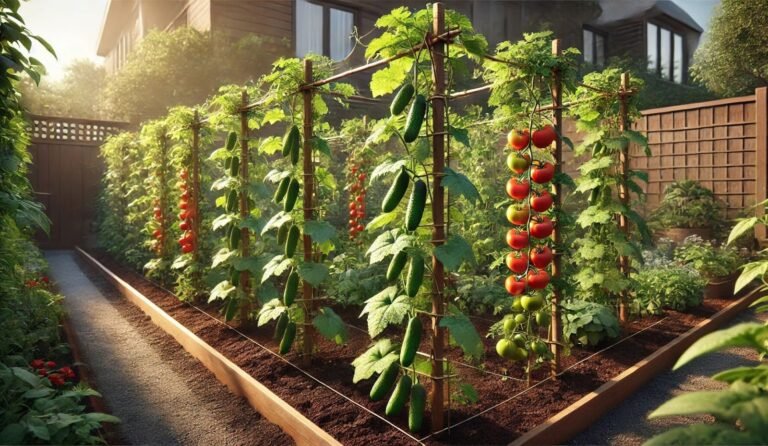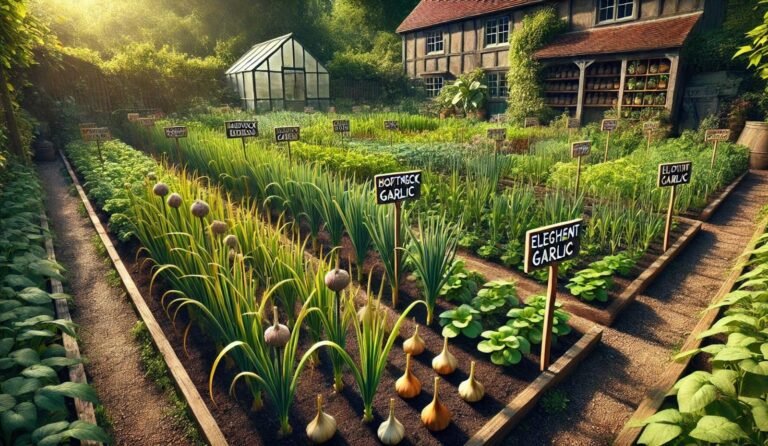Companion Plants for Garlic That Boost Growth and Flavor
Companion plants for garlic can make or break your garden. Pick the right ones, and you’ll have healthier garlic, fewer pests, and richer soil. Choose the wrong ones? Your garlic might struggle, or worse, fail to thrive. The good news? Certain veggies, herbs, and flowers play amazingly well with garlic. Stick around—we’re diving into the best (and worst) plants to grow alongside your garlic!
What Is Companion Planting?
Companion planting is the practice of growing different plants together to enhance their growth, improve soil health, and naturally repel pests. It’s a time-tested gardening technique used to create a balanced and productive ecosystem. Instead of relying on chemical pesticides and fertilizers, companion planting lets nature do the work for you. Certain plants have natural properties that benefit others when grown nearby.
Some release compounds that deter pests, while others improve soil structure or attract pollinators. For example, garlic’s strong scent makes it an excellent natural pest repellent, helping protect its neighboring plants.
By strategically choosing companion plants, you can reduce plant diseases, increase yields, and create a healthier, more sustainable garden. Whether you’re growing vegetables, herbs, or flowers, companion planting can significantly boost your gardening success.
Why Companion Plants for Garlic Matters
Companion planting is more than just a gardening trick—it’s a science-backed method that enhances plant health and productivity. When done correctly, it can create a natural ecosystem that improves soil nutrients, controls pests, and even enhances the flavor of your crops.
Garlic, in particular, is a powerhouse plant when it comes to companion planting. Its strong scent naturally repels many common garden pests, while its antibacterial and antifungal properties can help prevent plant diseases. Additionally, garlic doesn’t require much space, making it an excellent companion for a variety of vegetables, herbs, and flowers.
The Best Companion Plants for Garlic
Choosing the right plants to grow alongside garlic can make all the difference in your garden’s success. Here are some of the best companions for garlic and why they work so well together.
Vegetables That Thrive with Garlic
Some vegetables benefit immensely from being planted near garlic. These plants either repel pests, improve soil health, or have compatible root systems that won’t interfere with garlic’s growth.
Tomatoes
Tomatoes and garlic make an excellent pair in the garden. Garlic helps deter spider mites, aphids, and whiteflies, all of which can wreak havoc on tomato plants. Additionally, garlic’s natural fungicidal properties help prevent diseases like blight, which tomatoes are particularly susceptible to.
Carrots
Carrots and garlic are great companions because they complement each other underground. Carrots have long taproots, while garlic has shallow roots, meaning they don’t compete for nutrients. Additionally, garlic helps repel carrot flies, which can damage carrot crops.
Beets
Beets and garlic can share space in the garden without interfering with each other’s growth. Garlic’s pest-repelling qualities help protect beets from common insects, while beets don’t compete aggressively for nutrients, making them a low-maintenance companion.
Lettuce and Spinach
Leafy greens like lettuce and spinach thrive next to garlic. Garlic acts as a natural deterrent against aphids, slugs, and snails—common pests that feed on tender green leaves. Plus, lettuce and spinach grow quickly and can be harvested before garlic reaches full maturity.
Peppers
Garlic’s pungent aroma confuses and deters pests that typically attack pepper plants, such as aphids and spider mites. Peppers also have a compact root system that doesn’t interfere with garlic’s growth, making them a harmonious companion in the garden.
Herbs That Grow Well with Garlic
Some herbs benefit from garlic’s protective qualities, while others can enhance its growth by attracting pollinators and beneficial insects.
Dill
Dill attracts beneficial insects like ladybugs and parasitic wasps, which help control harmful pests that might otherwise attack garlic. It’s a great companion for garlic because it improves the overall biodiversity of your garden.
Chamomile
Chamomile enhances the flavor of garlic when planted nearby, thanks to its ability to improve soil health. It also attracts pollinators and beneficial insects while repelling unwanted pests.
Rue
Rue is known for its strong scent, which can deter many garden pests. When planted alongside garlic, it helps keep away aphids, beetles, and other harmful insects.
Yarrow
Yarrow is an excellent companion plant for garlic because it attracts predatory insects that feed on garden pests. Its deep root system also helps loosen the soil, improving aeration and drainage for garlic plants.
Flowers That Benefit Garlic Growth
Flowers are often overlooked when it comes to companion planting, but some varieties can be incredibly beneficial when grown near garlic.
Marigolds
Marigolds are famous for their ability to repel nematodes—microscopic worms that can damage garlic roots. They also deter aphids, whiteflies, and other common pests, making them a great choice for planting near garlic.
Nasturtiums
Nasturtiums act as a trap crop by attracting aphids away from garlic and other vegetables. This helps protect garlic plants while also adding beauty to your garden.
Bad Companion Plants for Garlic (What Not to Plant Near Garlic)

While many plants thrive when grown alongside garlic, some should be avoided because they either compete for nutrients or hinder garlic’s growth.
Beans and Peas
Legumes like beans and peas should not be planted near garlic because they fix nitrogen in the soil, which can slow down garlic’s growth. Additionally, garlic’s strong scent can interfere with their development.
Asparagus
Asparagus and garlic have conflicting root systems that make them poor companions. Garlic can stunt the growth of asparagus, making it difficult for both plants to thrive together.
Sage and Parsley
While many herbs benefit from garlic’s presence, sage and parsley do not. Garlic can inhibit their growth, leading to weaker plants and lower yields.
Strawberries
Strawberries are highly susceptible to fungal diseases, and planting them near garlic increases the risk of infection due to soil interactions. Additionally, garlic can alter the flavor of strawberries in an undesirable way.
How to Companion Plant Garlic for the Best Results
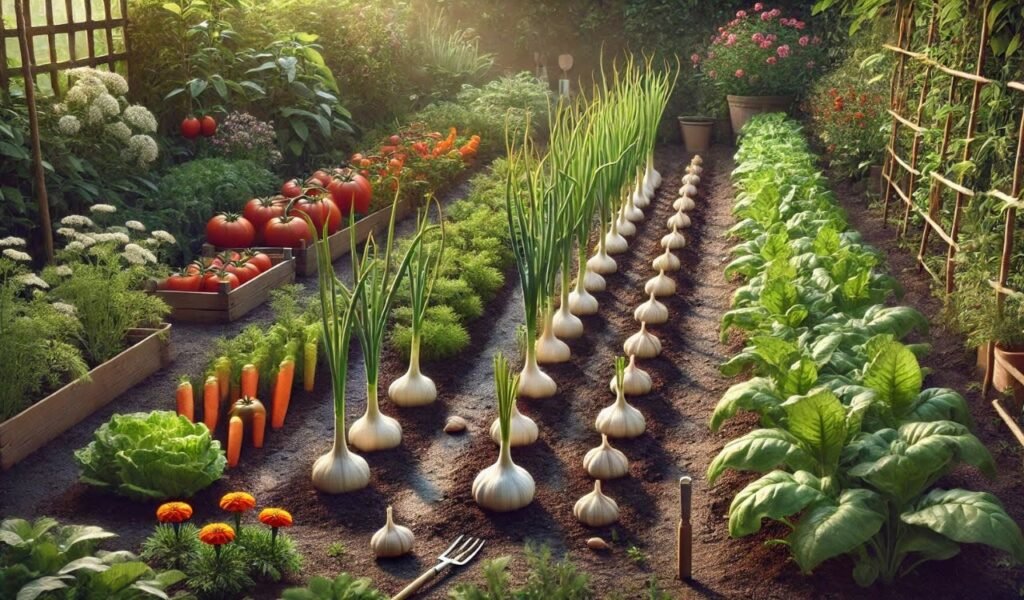
To maximize the benefits of companion planting with garlic, follow these best practices:
Spacing and Planting Tips
Garlic needs space to grow, so plant it at least 4-6 inches apart. When interplanting with companion crops, ensure each plant has enough room to develop without competing for nutrients.
Soil and Water Considerations
Garlic thrives in well-drained, nutrient-rich soil. When planting alongside other vegetables and herbs, choose plants with similar soil and watering needs to prevent overwatering or nutrient depletion.
Seasonal Considerations
Garlic is typically planted in the fall and harvested in late spring or early summer. Plan your companion planting strategy accordingly to ensure all plants reach their full potential without interfering with each other’s growth cycles.
Common Mistakes to Avoid in Companion Planting with Garlic
Even experienced gardeners make mistakes when planting companion plants. Here are some pitfalls to watch out for:
Overcrowding
Planting too many crops close together can lead to competition for nutrients and reduced airflow, increasing the risk of disease.
Ignoring Plant Compatibility
Not all plants get along with garlic. Be mindful of which plants you place near it to avoid growth inhibition.
Neglecting Soil Health
Companion planting works best in nutrient-rich soil. Regularly amend your soil with compost or organic matter to keep it fertile.
FAQ
1. What are the best companion plants for garlic?
The best companion plants for garlic include tomatoes, carrots, lettuce, spinach, peppers, chamomile, dill, marigolds, and nasturtiums. These plants help repel pests, improve soil health, and enhance garlic growth.
2. What plants should not be grown near garlic?
Avoid planting beans, peas, asparagus, sage, parsley, and strawberries near garlic. These plants can compete for nutrients, hinder garlic’s growth, or be negatively affected by garlic’s strong scent.
3. Why does garlic make a good companion plant?
Garlic repels many common garden pests like aphids, spider mites, and cabbage worms. It also has natural antifungal properties that help prevent plant diseases and improve overall garden health.
4. Can I plant garlic with flowers?
Yes! Flowers like marigolds and nasturtiums make excellent companions for garlic. Marigolds repel nematodes, while nasturtiums attract beneficial insects that protect your garden.
5. Does garlic improve the flavor of other plants?
Some herbs, like chamomile and dill, are believed to enhance garlic’s flavor, while garlic itself can intensify the taste of nearby vegetables by improving soil health.
6. Can I grow garlic in containers with companion plants?
Absolutely! Garlic grows well in pots, and you can pair it with lettuce, spinach, or herbs like dill and chamomile to maximize space and benefits.
7. When is the best time to plant garlic with companion plants?
Garlic is usually planted in the fall for a summer harvest. Plan your companion planting accordingly so that neighboring plants complement garlic’s growing cycle.
Final Thoughts
Companion planting with garlic is a fantastic way to create a thriving, pest-resistant garden. By choosing the right companion plants, you can enhance garlic’s growth, protect it from pests, and improve soil health. Whether you’re growing garlic in a backyard garden or indoors, thoughtful companion planting will ensure a successful and bountiful harvest.
Experiment with different companion plants and observe what works best in your garden. Over time, you’ll develop a natural, symbiotic growing system that supports both garlic and its neighboring plants. Happy planting! 🌱🧄

